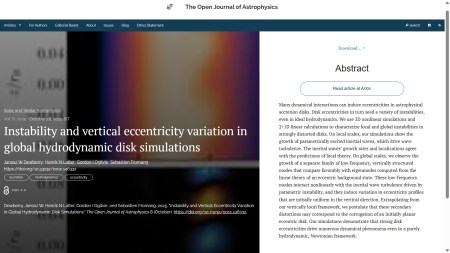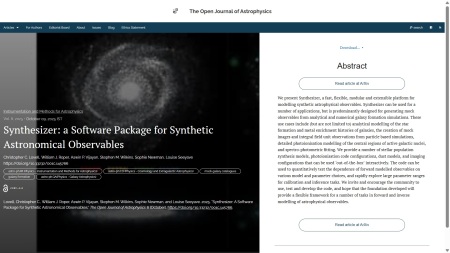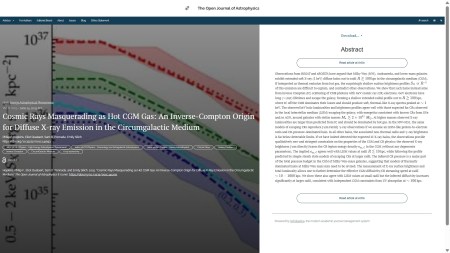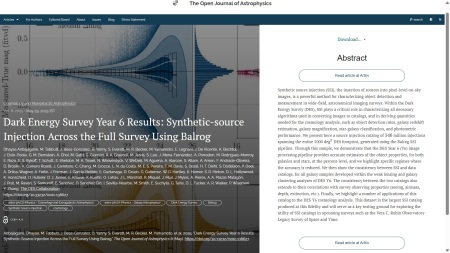Weekly Update from the Open Journal of Astrophysics – 22/11/2025
It’s Saturday again, so it’s time for the usual update of the week’s new papers at the Open Journal of Astrophysics. Since the last update we have published another five papers, which brings the number in Volume 8 (2025) up to 180, and the total so far published by OJAp up to 415.
The first paper to report this week is “Probing Anisotropic Cosmic Birefringence with Foreground-Marginalised SPT B-mode Likelihoods” by Lennart Balkenhol (Sorbonne Université, France), A. Coerver (UC Berkeley, USA), C. L. Reichardt (U. Melbourne, Australia) and J. A. Zebrowski (U. Chicago, USA). This paper was published on Monday November 17th in the folder Cosmology and Nongalactic Astrophysics. It presents a way of using data from the Souh Pole Telescope (SPT) in the CMB-lite framework to constrain the level of cosmic birefringence. The overlay is here:
You can find the officially accepted version on arXiv here and the The Fediverse announcement is here:
Open Journal of Astrophysics
New Publication at the Open Journal of Astrophysics: "Probing Anisotropic Cosmic Birefringence with Foreground-Marginalised SPT B-mode Likelihoods" by Lennart Balkenhol (Sorbonne Université, France), A. Coerver (UC Berkeley, USA), C. L. Reichardt (U. Melbourne, Australia) and J. A. Zebrowski (U. Chicago, USA)
https://doi.org/10.33232/001c.147459
November 17, 2025, 8:43 am 1 boosts 0 favoritesThe second paper of the week is “Radio Observations of a Candidate Redback Millisecond Pulsar: 1FGL J0523.5-2529” by Owen. A. Johnson & E. F. Keane (Trinity College Dublin, Ireland), D. J. McKenna (ASTRON, NL), H. Qiu (SKAO, UK), S. J. Swihart (Insitute for Defense Analyses, USA), J. Strader (Michigan State U., USA) and M. McLaughlin (West Virginia U., USA). This one was published on Tuesday November 18th 2025 in the folder marked High-Energy Astrophysical Phenomena and it describes a search for radio emission from a candidate “redback pulsar” J0523.5-2529 resulting in upper limits but no detection.
The overlay is here:
You can find the official version of this one on arXiv here. The federated announcement on Mastodon is here:
Open Journal of Astrophysics
New Publication at the Open Journal of Astrophysics: "Radio Observations of a Candidate Redback Millisecond Pulsar: 1FGL J0523.5-2529" by Owen. A. Johnson & E. F. Keane (Trinity College Dublin, Ireland), D. J. McKenna (ASTRON, NL), H. Qiu (SKAO, UK), S. J. Swihart (Insitute for Defense Analyses, USA), J. Strader (Michigan State U., USA) and M. McLaughlin (West Virginia U., USA)
https://doi.org/10.33232/001c.147516
November 18, 2025, 8:42 am 1 boosts 0 favoritesNext one up is “The role of turbulence in setting the phase of the ISM and implications for the star formation rate” by Tine Colman (Université Paris-Saclay, France) and 13 others based in France, Germany, Italy and the UK. This was published in the folder Astrophysics of Galaxies on Tuesday November 18th. It descrtibes using a suite of stratified box simulations to explore the link between star formation, turbulence and the thermal state of the multi-phase interstellar medium (ISM).
The overlay is here:
You can find the official accepted version on arXiv here. The fediverse announcement is here:
Open Journal of Astrophysics
New Publication at the Open Journal of Astrophysics: "The role of turbulence in setting the phase of the ISM and implications for the star formation rate" by Tine Colman (Université Paris-Saclay, France) and 13 others based in France, Germany, Italy and the UK.
https://doi.org/10.33232/001c.147517
November 19, 2025, 8:19 am 0 boosts 0 favoritesThe fourth paper of the week is “A Bimodal Metallicity Distribution Function in the Ultra-Faint Dwarf Galaxy Reticulum II” by Alice M. Luna (U. Chicago, USA) and 8 others based in the USA, Korea and Canada. This was published on Wednesday November 19th in the folder Astrophysics of Galaxies. It decribes low-resolution Magellan/IMACS spectroscopy of 167 stars in the ultra-faint galaxy Reticulum II, revealing a clearly bimodal distribution.
The overlay is here:
You can find the official published version on arXiv here. The Fediverse announcement follows:
Open Journal of Astrophysics
New Publication at the Open Journal of Astrophysics: "A Bimodal Metallicity Distribution Function in the Ultra-Faint Dwarf Galaxy Reticulum II" by Alice M. Luna (U. Chicago, USA) and 8 others based in the USA, Korea and Canada.
https://doi.org/10.33232/001c.147696
November 19, 2025, 8:37 am 0 boosts 0 favoritesThe fifth and final paper for this week is “Cool Gas in the Circumgalactic Medium of Massive Post Starburst Galaxies” by Zoe Harvey, Sahyadri Krishna, Vivienne Wild & Rita Tojeiro (U. St Andrews, UK) and Paul Hewett (U. Cambridge, UK). This was published on Thursday November 20th in the folder Astrophysics of Galaxies.
The overlay is here:
The officially accepted version can be found on arXiv here. The Fediverse announcement is here:
Open Journal of Astrophysics
New Publication at the Open Journal of Astrophysics: "Cool Gas in the Circumgalactic Medium of Massive Post Starburst Galaxies" by Zoe Harvey, Sahyadri Krishna, Vivienne Wild & Rita Tojeiro (U. St Andrews, UK) and Paul Hewett (U. Cambridge, UK)
https://doi.org/10.33232/001c.147836
November 20, 2025, 9:02 am 1 boosts 0 favoritesAnd that concludes the update for this week. I will do another next Saturday.
#arxiv250303305v4 #arxiv250616462v2 #arxiv250622287v3 #arxiv250815435v2 #arxiv251007928v2 #astrophysicsOfGalaxies #cosmicBirefringence #cosmicMicrowaveBackground #cosmologyAndNongalacticAstrophysics #diamondOpenAccess #diamondOpenAccessPublishing #highEnergyAstrophysicalPhenomena #interstellarMedium #openAccess #openJournalOfAstrophysics #polarization #redbackPulsar #reticulumIi #spectroscopy #theOpenJournalOfAstrophysics #turbulence #ultraFaintDwarfGalaxy






